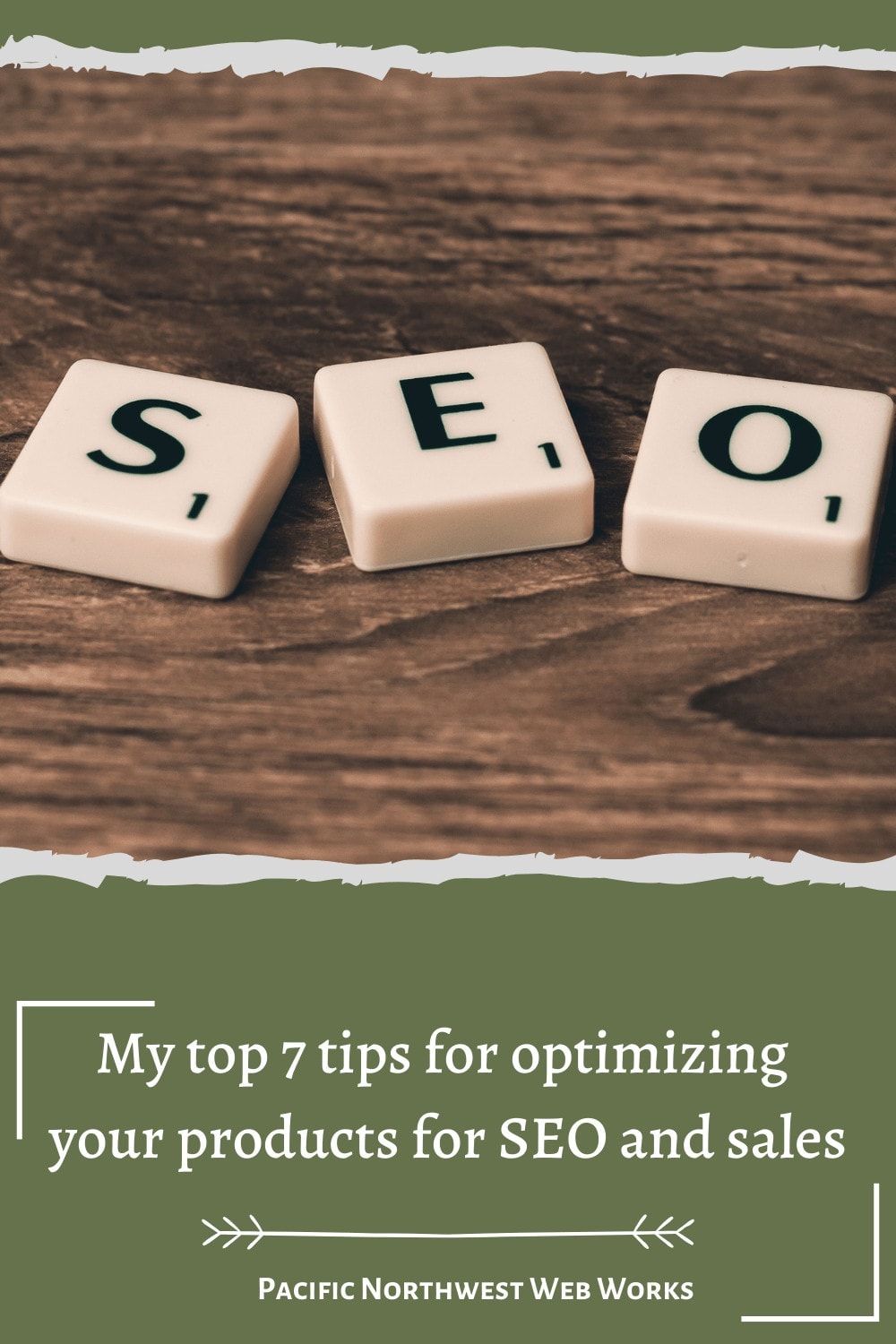Running your store can seem like a daunting task if you are only focusing on pushing sales. And everyone says you need great SEO to rank and be seen. But what if great SEO could come naturally?
No keyword stuffing, no perfect random scores from SEO experts. You can rank content by simply providing the right information and answering the right questions. It’s all about knowing who you are talking to, what they are looking for, and how they talk.
So, what does it take then to rank products in your store on Google and other search engines? Let’s look at my top 7 recommendations to help you rank your products, so they are found by those who matter the most and increase your sales at the same time.
Write clean titles
Product titles are the first impression to potential viewers. The goal of the title is to convey what the product is in the simplest terms. It should be descriptive and specific.
You don’t want a long title. Most search engines only give your title around 60 characters. If you are focused on branding your business name, you might even have less than that. Anything longer and it will be hidden behind ellipsis anyway.
A good way to SEO format your title is to put the product name first and the brand name last.
Meh example: My very cool widget – My Great Brand
Great example: Pink Camo Women’s Bracelet with US Army Charm – Brand Jewelry
The title should contain a keyword or phrase you want the product to rank for. In my first example above, the keyword would be ‘widget’. The second has a few different key terms, ‘Women’s bracelet’ and ‘US Army Charm’. The second is a much better title.
A short trick I recommend you use is to read the title to someone else. Ask them to close their eyes while you read it and picture in their mind the title. You only give them the title. Don’t describe the item at all. Then have them tell you what they think it looks like from just the title. Of course, this works best when they have never seen the item before.
Give critical details
I can’t tell you how many times I have been browsing for a product and trying to decide between two brands. I will be searching through all the details and then something will be missing. How big was this item? Did that come with all the parts shown in the picture?
The company that wins my business is the one that makes all the details clear.
No, I am not meaning a long story about the history of the product. And no, I don’t mean that your description should not be fun either. I am talking about the extras that help me decide if your product is the right one for me.
Details like bracelet length in my title example above. Also, materials, clasp type, etc. Anything I would need to know if I can use this product. If your product is bound by regulations, such as soaps that must have the ingredients and size listed, make sure you include the full ingredients list and proper sizing.
You should also include extra that can make a sale easier. Say, for example, your product is sourced from a reputable (and known to your customer) source. Or it is free from a certain chemical. Or made from local materials.
The extra details can be the difference between a sale and someone walking away.
Leave out the fluff
It can seem like a great idea to add that story of how it was made or the history of an ingredient. But is it going to help you make sales?
As you write titles and descriptions, ask yourself a couple of questions:
What does that mean?
Who cares, and why should they care?
If you evaluate the content you write against these filters and can honestly answer why a piece of text is there, then keep it. If not, drop that fluff.
Fluff will not help you rank. But if you are clear in your descriptions, give all the relevant information, and include key terms that you want that product to be known for, you will stand a much better chance of ranking.
Keep the information short and sweet. Don’t write a novel when you need five words to answer the questions in my mind and get me to hit buy now.
Too much text can hurt your sales as people get lost in the fluff and then walk away.
Don’t exhaust your customer’s minds.
Create unique content

This one should seem obvious, but if you want to rank for SEO, you must write your content. Don’t copy someone else, and don’t take the manufacturer’s description.
Search engines reward unique and fresh content that answers the exact question or query. Generic descriptions are just that. Generic.
How do you expect to rank when everyone under the sun that sells that product uses the same description as you do? You are lost in a sea of boring.
Create your content from scratch and stand out from the crowd. No one else knows your customers better. Talk straight to them. They will understand you better and reward you with sales.
Write as you would write to a friend. Just pick a single customer and write to that one, like you are having a true conversation.
A little thing to note here, however. Some items require disclosure or notice written in a certain way. If your product requires details like this, make sure you follow those instructions and include them.
This does not mean you cannot write more personal content to surround the required text. And the search engines will reward you for the uniqueness and understand that the required bit shows everywhere and not hold it against you.
An example of this is certain manufacturers require disclosure when you use their product, or component inside your product. For example, candles with some wooden wicks must have a patent notice on them, per the manufacturer of those wicks.
Use real search terms
If you want to rank for a search term, it needs to be authentic and specific. Do you want to rank for ‘widgets’ which could mean anything, or would you rather rank for ‘magic calculating widget’?
Think of this another way. When you search for something, do you try to be specific, so you get the best results? EG: pet-friendly hotels near Yellowstone national park vs hotels in Idaho.
Focus on what your customers search for and how they search. Use their actual words and terms in your titles and descriptions. If your customer base calls your scents flavors instead, then you might want to adopt that term and use it yourself.
Customer research is great here. Talk to your customers and ask them how they found you. Or if you travel to markets, listen to the conversations in your booth. Your customers are dropping key terms and words they use to describe your product to others in the conversations they are having amongst themselves and with you.
Take notes and keep track of trends in these conversations.
You can use tools like Google’s Keyword Planner (https://ads.google.com/home/tools/keyword-planner/) to then research those terms and learn how many others are using those same terms. If it is common and on-brand for you then use it.
Focus on long-tail key terms like my Yellowstone example above. Long-tail terms are much easier to rank for specifically. And if they get enough traffic, you could have it made.
Have great product photos

Search engines are evolving. Some, like Pinterest, are learning to read images. They can determine if the photo is likely to invoke certain emotions and pick out what it should describe.
And you should not focus just on search engines. You need to have clear and clean product photos that attract the right buyers. Think about the emotion you want to convey and use the right image to do so.
Make the photos enticing. Invite the buyer to want to learn more about your product. Keep it product-focused and show them what they are getting.
Include only those props which will support your product. If you sell scented thingamajigs, then add keynotes of the scent in the photo background. Use a clean layout or solid colored sweeping backdrop.
Feel free to showcase ‘in use’ photos as well. This allows people to place themselves inside the photo and imagine using your product. It brings them into the narrative.
Make sure to properly crop your photos for your store. And don’t forget to title the photo as well. ‘NC_12345’ means nothing, but ‘Pink army charm bracelet on women’s wrist’ means tons.
Keep this in mind for the ALT tag too. You *must* provide a good descriptive ALT tag. And yes, I said MUST. If you forget the ALT tag you are forcing those with a disability to rely on either nothing or the ‘NC_12345’ as the only description of what that image is. This does not help you sell and hurts those who are unable to see your store as you can.
Focus on people, not engines
Always remember in the end you are selling to other people. You are not selling your product to search engines.
Put the people first in everything you produce. Worry less about the ranking and focus on the people. Bring the natural relationship to them. Be authentic in yourself and your products.
Search engines are pretty darn smart. They know when you are stuffing words in for them and will drop you fast. They also understand when you are being truthful and honest about your items.
Plus, ranking is determined partly by factors such as bounce rate. If you stuff your product descriptions or have horrible photos, people will arrive and turn right back around. These bounces will eventually hurt your rank, as the search engine thinks ‘hmm, they clicked that page for XYZ term but came right back, this page must have nothing to do with XYZ’.
Make it natural, and human-focused. Use the key terms that you researched and fit them naturally into your text. Describe your images properly, with real human descriptions.
If you are worried about sounding robotic, read it out loud or to someone else. You will quickly be able to determine if the voice is the right one you are trying to convey.
Wrap up
Remember, optimizing your products for both SEO and sales go hand in hand. If you work hard to make your products authentic and relatable to your customers, you will rank just as easily.
You alone know your brand and your customers. If you talk to them like you would if they were in front of you it goes a long way. And the search engines reward that conversation. Now it’s your turn. Go look at your products and see how you can improve them.







